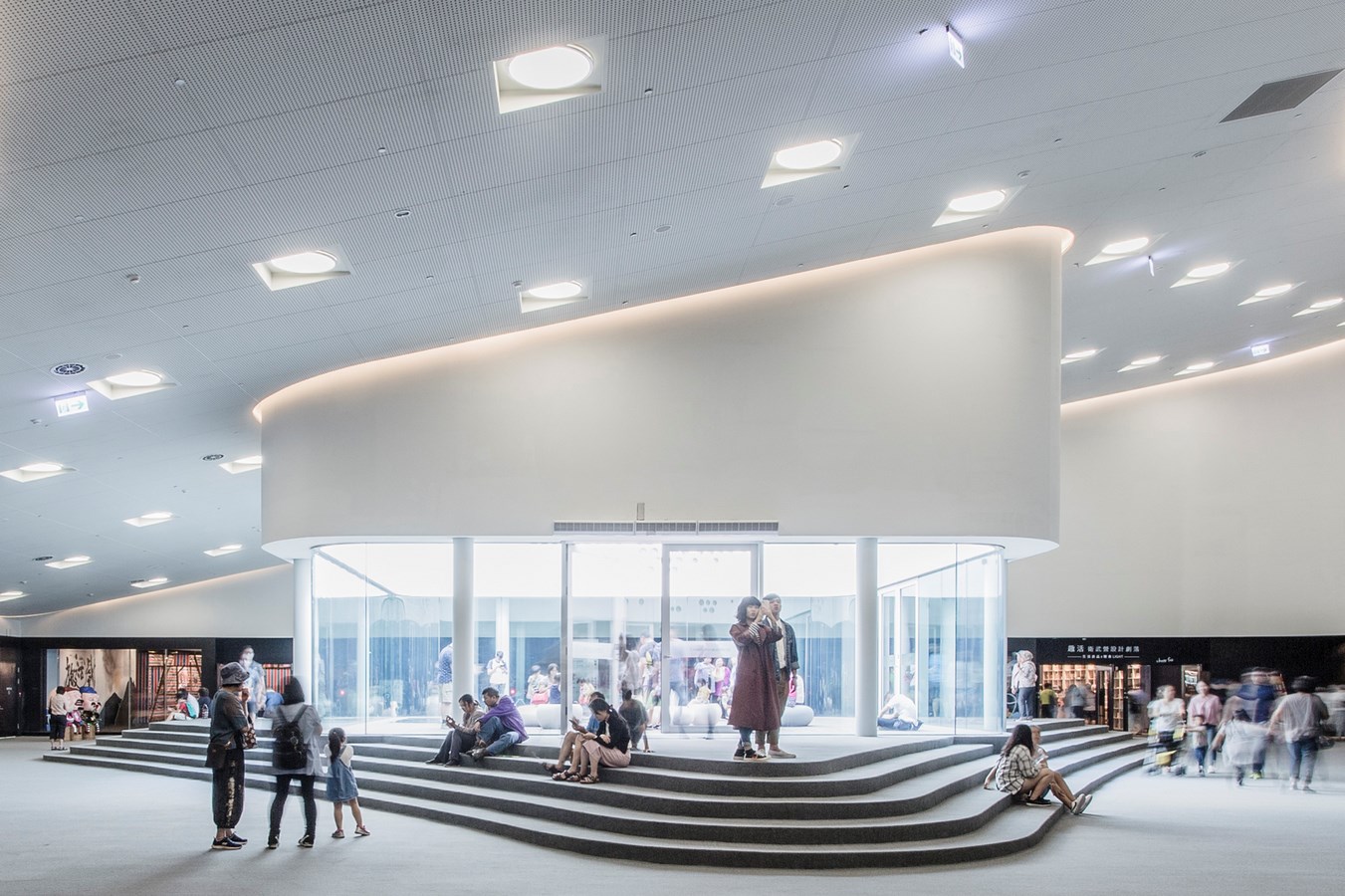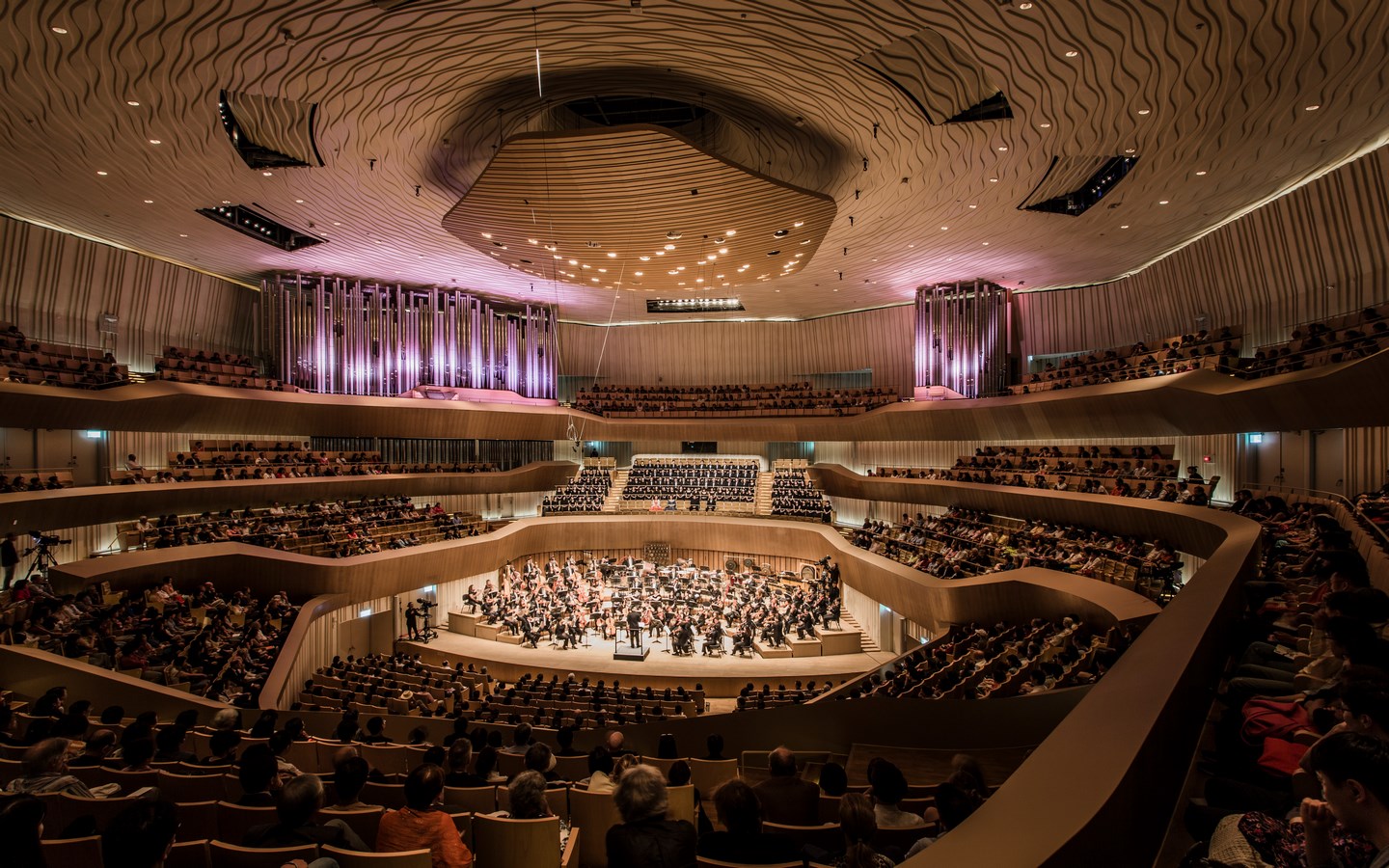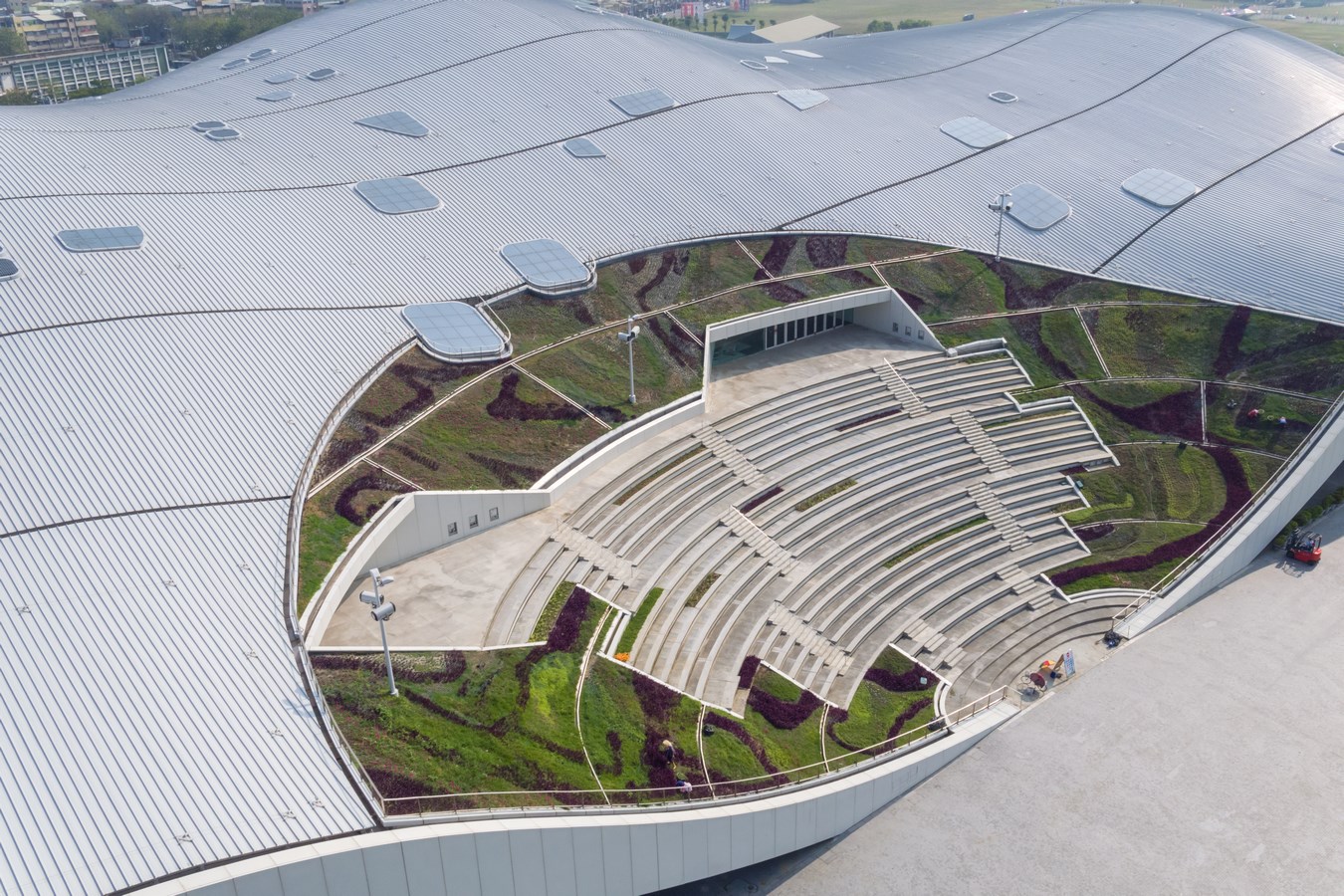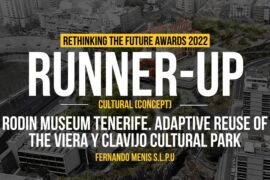Kaohsiung is an informal, lively city of almost three million inhabitants. Not only is it the second largest city in Taiwan and one of the world’s largest sea ports, but also host to a dramatic sub-tropical climate of typhoons, high temperatures, heavy rainfall and regular earthquakes. The new 140,000 square-metre performance complex must cope with all of these extremes.
Architect: Mecanoo architecten, Delft, the Netherlands
Local partner: Archasia Design Group, Taipei, Taiwan
Site supervision: Archasia Design Group, Taiwan
Partner in charge: Francine Houben
Project architect: Nuno Fontarra
Project director: Friso van der Steen
Design Team: Aart Fransen, Bohui Li, Ching-Mou Hou, Danny Lai, Frederico Francisco, Jaytee van Veen, Joost Verlaan, Leon van der Velden, Magdalena Stanescu, Nicolo Riva, Rajiv Sewtahal, Reem Saouma, Sander Boer, Sijtze Boonstra, Wan-Jen Lin, Yuli Huang, William Yu, Yun-Ying Chiu.

Barking dogs and banyan trees
The location for this building is a former sixty-five hectare military compound in the centre of the metropolitan area of Kaohsiung – a place which is intended to become a sort of ‘Central Park’ for the city. When we first visit the site in 2006 it is still a fenced-off zone of military barracks occupied by a lot of wild, barking dogs. It’s also dense with banyan trees, their twisting trunks and branches having gradually interlocked over decades. Their aerial shoots grow down into the soil forming additional trunks, spreading over an astonishingly wide area, and the crowns of these trunks become one, like a huge umbrella. According to local legend, Alexander the Great once sheltered his entire army beneath the crown of a single tree.

The form of the banyan reflects the local climate. Its wide crown, providing shelter against the sun and rain, is a perfect expression of Kaohsiung’s humid atmosphere. In the sub-tropics the sun sets at around six or seven o’clock and, just as it disappears beneath the horizon, the city comes to life. During these twilight hours as the temperature cools people stroll the streets, shop for their groceries, and eat outside. Under the canopies, as well as under the trees, informal performances occur: people dance, play music, perform plays, or practice Tai Chi. What we see, hear, feel, taste and smell on this first trip to Taiwan inspires us to somehow harness this unique urban atmosphere.

A continuation of the park
We wonder whether the banyan tree could help us to create a combination of formal and informal performance spaces. In this way the building would be full of life around the clock; a natural continuation of the park. We know that good public buildings need good public space, a mantra which is central to our approach to civic architecture: think of the Library of Birmingham’s sunken amphitheatre, or La Llotja de Lleida’s urban stage beneath a cantilever, using the stairs of an adjacent building as audience seating. The formal qualities of these three buildings are very different but they have one thing in common: they are a perfect match with their respective locations, cultures and climates.

The open, protective shape of the banyan tree becomes a springboard for the design. Its expansive sheltered crown becomes the Banyan Plaza, a partially enclosed public space where the cooling wind can freely flow. Between the four formal performance halls, which form the ‘trunks’ that support the undulating roof, a topography rising from ground level to plus five metres becomes part of the park’s landscape. Where the roof touches the earth the building becomes an amphitheatre, open towards the surrounding parkland which, in turn, becomes both its stage and its set.

Cargo ship
Each performance venue and foyer has its own unique atmosphere and together create one fluidly connected space. The walls and continuous ceiling surface of the Banyan Plaza is a neutral white, allowing for artificial light and projections to alter the mood. With twelve chandeliers suspended against the billowing form of the plaza, the building can really dress up for the night! But a question remains: how do you materialise a space the size of a cargo ship, almost 160 metres wide and 225 metres long? Should it be clad in stucco, tiles, aluminium, or steel?

A Piece of Banyan
In 2008 we are invited to design a pavilion for the Salone del Mobile in Milan. We decide to build ‘A Piece of Banyan’ – a 1:4 scale model of a sliced fragment, twenty metres long and three and a half metres wide, to research and test the proposed ceramic tile cladding for the Banyan Plaza. We affix tiles to the model reminiscent of the craquelé of Chinese porcelain and we also test the ambient lighting. The changing colours and atmospheres are spectacular; the tile cladding on the curved facades, on the other hand, is less of a success. For one, it’s raining heavily in Milan and is impossible to glue the tiles to the ceiling.

We continue our search for the building’s skin and the idea arises to use the finely tuned, locally accessible techniques of Kaohsiung’s ship building industry. We convince everyone that the Banyan Plaza should have the detailing of a cargo ship, and not of a luxury yacht. There should be hoist points, for example, so that lights, banners and fabric can be hung. We don’t want to aim for a perfectly smooth façade – we want to employ the ship builders to do what they do best: create a durable, long-lasting skin on a scale that some contractors would be intimidated by. We ultimately want the building to look like a ship on the land.

The four halls
Each of the four performance halls has its own acoustic challenge, and so we collaborate with acoustician Albert Xu. He constructs a 1:10 scale model to test the performance of the most complicated venue: the 2000-seat Concert Hall. Despite its size we want the theatre to have an intimate feel. Wouldn’t it be great if every member of the audience could see the hands of the pianist? We choose the shape of a stepped vineyard with a stage at its centre, so that terraces at different floor heights encircle the podium. With seating on all sides of the stage, the audience is in close proximity to the performance itself. The public enters the oak-lined from the ground floor and spiraling ramps lead them to their golden seats.

The 2260-seat Lyric Theatre (also known as the Opera House) is arranged in the form of a horseshoe with three circled balconies. The seating is upholstered in a mixture of red and purple fabrics with a pattern of Taiwanese flowers, contrasting with the darker walls. This theatre is not only suitable for Western opera, with an orchestra of over seventy musicians, but can also be acoustically adapted to accommodate Chinese opera by manoeuvring a suspended acoustic canopy.

The Playhouse, with its 1,243 seats in Mecanoo Blue, is designed to host a variety of drama and dance performances. Flexibility is the core element in the design of this multifunctional space. The layout is adaptable and can be changed from a typical proscenium stage with the audience in front, to a thrust stage with the audience on three sides.

The 470-seat Recital Hall has the most intimate atmosphere of the four. With its asymmetrical composition and seating across two levels, it is designed for chamber music and recital performances. The seats have the same golden fabric as the Concert Hall and oak lines the walls. The upper part of this hall is enclosed by a circle of sound absorbing curtains, allowing for the reverberation time within the space to be tuned to specific types of performance.
Facts National Kaohsiung Center for the Arts
- The building is 225m long and 160m wide, covers a footprint of 36,000 m2.
- The name, Weiwuying is derived from the surrounding metropolitan park that until 1979 accommodated a military base
- Mecanoo’s repertoire has included the Library of Birmingham, the train station of Delft and the ongoing renovation of New York Public Library
- Francine Houben first visited Kaohsiung in 2006, when Mecanoo entered a competition organised by Taiwan’s national government to design the third and final national performing arts centre.
- Houben’s first impressions of Kaohsiung were of barracks, barking dogs and banyan trees.
- In Chinese culture, Banyan trees often play host to events and improvised gatherings, and are a cherished presence in parks, including Weiwuying Metropolitan Park.
- The Banyan Plaza is the entry point to Weiwuying. It occupies the entire footprint of the building, flowing with the surrounding landscape and rising and ebbing to conceal technical spaces underfoot.
- The floor of the Banyan Plaza is finished is PU resin floor
- The underside of the canopy is clad in 2320 steel plates 6mm thick and individually curved. Total steel skin surface area is 23,000 m2; the total weight is 1,520 tonnes.
- Mecanoo first presented their idea for the Banyan Plaza at Milan’s Salone del Mobile in 2008, in the form of a pavilion titled ‘A Piece of Banyan’. This pavilion was covered in ceramic tiles
- Apart from tile, Mecanoo also experimented with aluminium and stucco for the Banyan plaza, before settling on steel plates
- The welds between the plates are kept visible so the building would resemble a cargo ship
- There are markings imitate the waterline to indicate height above sea level at various points in the plaza.
- The space is flooded with natural light by day, at night it is illuminated with an array of lighting so it can be dressed to suit its programme. The lighting includes flying-saucer like pendant lights with a diameter of 3500mm.
- From the Banyan plaza, there are entrances to four foyers, leading to the opera house, play house, concert hall and recital hall.
- In the foyers, the colour palette is white plaster ceilings and walls, black and white painted walls, black plinth walls, dark grey granite tiled flooring.
- The opera house is the biggest auditorium, positioned at the centre of the building. It has 2236 seats and a colour scheme of three shades of red and black.
- The horseshoe layout of the opera house ensures no seat is more than 38m from the stage
- Acoustics in the opera house are optimised for clarity, as audiences will mostly be watching performances in foreign languages
- This is the thirdedicated national opera house to be built in Taiwan (The 1st and 2nd are: the National Theater and National Taichung Theater)
- The playhouse, with 1210 seats, is meant for experimental theatre and Chinese opera
- The recital hall has 434 seats
- The concert hall has 1981 seats, with vineyard style seating that avoids cantilevered balconies, so every audience member can enjoy the sound reflection from the ceiling
- The double organ manufactured by Orgelbau Klais, and shaped like a bamboo grove. With a total of 9,085 pipes, which includes a symphonic organ (7,169 pipes) and an echo organ (1,916 pipes). The organ in WWY is the largest one Orgelbau Klais ever built in the history of the company founded in 1882.
- The flooring and balustrades are made of oak
- The seatings of concert hall and recital hall are upholstered in champagne-coloured mohair
- The contoured ceiling is in beige GRG – Glass Reinforced Gypsum
- On 13 October, the concert hall will play host to Weiwuying’s inaugural show, titled Glittering Sound and bringing together local and international performances. Houben will be in the audience with her entire family.
- There will be a public party the same evening in the outdoor amphitheatre
- The cost of the building came in at 10.7 billion NTD/ 366 million USD/ 258 million GBP, exactly on budget.
- Future international visitors include the Berlin Philharmonic Orchestra and Robert Lepage; Cloud Gate is also booked to appear
- There is a ‘Weiwuying Unlimited’ membership available at NTD25,000 a year, including access to every show on the calendar.
Design: 2007-2009
Realization / Construction phase:
Start April 2010 – December 2017 substantial completion
January 2018 – September 2018 Trial period/Testing
October 2018 Grand Opening
Site area: 10 ha (3 ha building, 7 ha park), Metropolitan park 64 ha.
Costs: 10.7 billion NTD/ 366 million USD/ 258 million GBP
Address: No. 1, Sanduo 1st Road, Fengshan District, Kaohsiung City, 83075 Taiwan
Client: Ministry of Culture
Programme: Theatre complex in the Wei-Wu-Ying Metropolitan Park with a total capacity of 5861 seats: Concert Hall 1981 seats, Opera House 2236 seats, Playhouse 1210 seats, Recital Hall 434 seats, public library of 800 m2, rehearsal/education halls for music and dance, 2 congress halls with 100 and 200 chairs and stage building workshops. Including 7ha landscape.
Awards: 1st prize Cityscape Architectural Award, Dubai 2008; 3rd prize International Design Award, IDA Los Angeles 2009; Chicago Athenaeum International Architecture Award 2009; Digital prize at Idea-Tops Awards 2017.
Consultants:
Structural engineer: Supertech, Taiwan
Mechanical engineer: Yuan Tai, Taiwan
Electrical engineer: Heng Kai, Taiwan
Acoustic consultant: Xu-Acoustique, France
Theatre consultant: Theateradvies, The Netherlands; Yi Tai, Taiwan
Lighting consultant: CMA lighting, Taiwan
Fire safety: Ju Jiang, Taiwan
Organ consultant: Oliver Latry, France
Roof and façade consultant: CDC, USA
3D consultant: Lead Dao, Taiwan
Traffic consultant: SU International, Taiwan
Contractors:
1st tender: Chien Kuo Construction Co., Taiwan
2nd tender: Chien Kuo Construction Co., Taiwan/ Chung Hsin Electric & Machinery Manufacturing Corp., Taiwan/ Shinex Machinery Engineering Inc., Taiwan
3rd tender: L&K Engineering Co., Taiwan/ RSEA ENGINEERING CORP., Taiwan / Waagner-Biro, Austria /IX Technology, Taiwan
4th tender: C.F. Piano, Taiwan/ Klais, Germany
5th tender: Jaie Haour Group, Taiwan
6th tender: Kaohsiung City Government, Taiwan
7th tender: Fuji Xerox, Taiwan
Materials:
Roofing: BEMO, Germany
Theater seating: KOTOBUKI SEATING CO., LTD, Japan
Stage systems: Waagner Biro, Austria
Organ: Orgelbau Klais, Germany
Steel structure: Chun Yuan Steel Industry Co., Ltd, Taiwan
Steel skin of Banyan Plaza: Ching Fu Shipbuilding Co., Ltd., Taiwan + CIG, The Netherlands
Glass: Taiwan glass group, Taiwan
Curtain wall: He-Tai Co., Ltd., Taiwan
GRG panels: Hung Meng International development Co., Ltd., Taiwan
Calcium silicate board: Wellpool Co., Ltd., Taiwan
Carpet: Chin Chin Carpet, Taiwan
Wood flooring and handrails: Jin-Bai Co., Ltd., Taiwan





